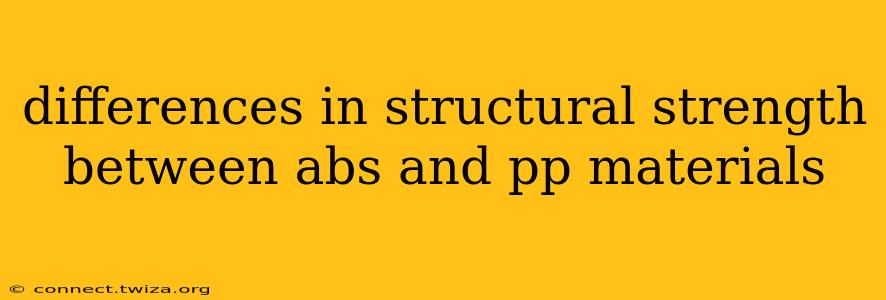The Strength Showdown: ABS vs. PP Plastics
Acrylonitrile Butadiene Styrene (ABS) and Polypropylene (PP) are two incredibly common plastics used in a vast array of applications, from consumer goods to automotive parts. While both are durable and versatile, they exhibit key differences in their structural strength. Understanding these differences is crucial for selecting the right material for a specific project. This article will delve into the nuances of their structural properties, highlighting where each excels and where it falls short.
What is the Tensile Strength of ABS and PP?
Tensile strength, a measure of a material's ability to withstand pulling forces before breaking, is a crucial indicator of structural integrity. Generally, ABS boasts a higher tensile strength than PP. This means ABS can withstand greater stretching forces before failure. However, this is not a universal truth; the specific tensile strength values vary considerably depending on the grade and formulation of the plastic. Factors such as additives, fillers, and manufacturing processes significantly impact the final properties.
What is the Impact Strength of ABS and PP?
Impact strength, the ability of a material to absorb energy upon impact without fracturing, is another critical factor in structural strength. Here, the picture becomes more complex. While ABS generally exhibits good impact resistance, PP often surpasses ABS in this area, particularly at lower temperatures. This makes PP a preferred choice for applications requiring high shock absorption, such as protective casings or components subjected to repeated impacts.
What about Flexural Strength?
Flexural strength measures a material's resistance to bending. Both ABS and PP show reasonable flexural strength, but again, ABS generally edges out PP. This higher flexural strength makes ABS a better choice for applications requiring resistance to bending or warping.
How Does Temperature Affect the Strength of ABS and PP?
Temperature plays a significant role in the mechanical properties of both plastics. ABS tends to become more brittle at lower temperatures, whereas PP retains its impact strength better in cold conditions. Conversely, both materials can soften and lose strength at elevated temperatures, although PP generally exhibits a higher heat deflection temperature than ABS. This needs careful consideration for applications exposed to extreme temperatures.
Which Material is Stronger Overall?
There's no single answer to the question of which material is "stronger." The superior material depends entirely on the specific application and the type of stress the component will encounter. ABS excels in tensile and flexural strength, making it suitable for applications requiring high rigidity and resistance to stretching and bending. PP, on the other hand, often wins in impact resistance, especially at lower temperatures, making it ideal for applications prone to shocks and impacts.
What are the Main Differences in their Applications?
The differences in structural properties directly translate into different applications.
- ABS: Commonly found in housings for electronics, automotive parts (dashboard components, exterior trim), pipes, and toys. Its good strength and ability to be easily molded make it versatile.
- PP: Frequently used in containers (especially food containers), automotive parts (bumpers, interior trim), packaging, and medical devices. Its high impact resistance and chemical resistance are key advantages.
What are the factors influencing the strength of ABS and PP?
Several factors influence the final strength of both materials:
- Grade and Formulation: Different grades of ABS and PP exist with varying additives and fillers, influencing their mechanical properties.
- Manufacturing Process: Injection molding parameters, such as temperature and pressure, significantly impact the final product's strength.
- Additives and Fillers: The addition of fillers (like glass fibers) can significantly enhance the strength and stiffness of both materials.
In conclusion, the choice between ABS and PP depends heavily on the specific application and the type of stresses the component will experience. While ABS generally offers higher tensile and flexural strength, PP often boasts superior impact resistance, particularly at lower temperatures. Careful consideration of these factors is crucial for selecting the optimal material for a given project.
